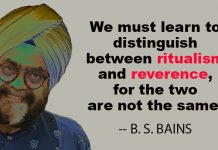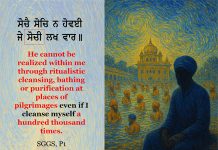
Abstract
In this reflective piece, Dr. B.S. Bains invites the Sikh Diaspora to re-examine the long-standing Sikh critique of rituals often labeled as “Hindu Matt.” He argues that the essence of Sikhism lies not in condemning others but in uplifting spiritual consciousness beyond outward forms while minimize or nullify any form of ritual act from the ethnic background you we may have come to learn the gist the messages our Gurus have been embarking on over 10 living Masters. While minimizing ritual, Dr. Bains further goes to say that we should do it without demeaning those who practise it and that is the truest path to harmony — one that reaffirms Sikhism’s role as a bridge of unity within the wider human family.
By Dr. B. S. Bains | Opinion |
For generations, Sikh scholars and preachers have condemned empty rituals, often linking them to what is commonly referred to as “Hindu Matt.” So much so it has been instilled into the minds of common Sikhs and often refer to this if they deny any rituals in their home. While this distinction once seems to have helped preserve the purity of Sikh thought and identity, it may now be creating unintended divides within the broader social and cultural fabric of India and around the universe especiallythe followers of the Hindu Faith under various sub groups. After all, many customs that Sikhs reject as “rituals” were once cultural practices shared across faiths — not merely religious boundaries. Perhaps it is time for Sikhs to re-examine the term “Hindu Matt” and consider whether its continued use promotes understanding or widens a rift between communities that share deep historical and spiritual roots.
We must also learn to distinguish between ritualism and reverence, for the two are not the same. Ritualism is often mechanical — an act performed out of habit, fear, or social expectation — whereas reverence is born from genuine love, awareness, and connection with the Divine. Not all rituals express reverence, and not all reverence requires ritual. When an act is filled with humility, mindfulness, and devotion, even the simplest gesture becomes sacred. But when the same act is done without understanding, it loses its spirit and becomes mere performance. Guru Nanak’s teaching reminds us to preserve the essence of reverence while freeing ourselves from the bondage of empty ritual.
The origins of this separation lie not in animosity but in reform. Guru Nanak sought to free spirituality from the grip of rigid ritualism and social hierarchies that shaped the religious life of his time — practices that often-instilled fear in the human mind with ideas of good or bad omens, or divine punishment for neglecting rituals. Such ritualism was visible in Arti, KadwaChawk, ritualistic prayers in Namaaz, and other socially structured observances. Performed merely as routine, these acts often lost their spiritual essence and became mechanical traditions. Guru Nanak, however, perceived them as aspects of culture rather than genuine pathways to the Divine. He did not condemn them outright but gently elevated their meaning — transforming ritual into reflection through the wisdom of his divine poetry. His message emphasized simplicity, equality, and direct communion with the Divine — a call to nurture inner devotion over outward display.
Over centuries, however, the colonial narrative of defining communities into neat religious boxes — “Hindu,” “Muslim,” and later “Sikh” — deepened distinctions that were once fluid. What began as a spiritual reform within the Indian ethos gradually evolved into an assertion of distinct identity. In that process, the phrase “Hindu Matt” became less a theological critique and more a social marker — one that now risks overshadowing the shared moral and cultural lineage between Sikhs and Hindus.
In today’s interconnected world, where divisions often breed misunderstanding, it may be time for Sikhs to reclaim Guru Nanak’s original vision — one that transcended caste, creed, and religious barriers. True Sikh teachings are not threatened by dialogue or shared heritage; they are, in fact, meant to strengthened and enriched our inner systems. Sikhism was born out of conversation — a fearless dialogue between truth and illusion, between self and society, between rituals and deed. Guru Nanak himself travelled far and wide, engaging with Hindus, Muslims, Sufis, and yogis, not to challenge their faiths but to illuminate their understanding through divine wisdom. When Sikhs embrace dialogue, they continue that same sacred journey — one that replaces judgment with understanding and separation with shared discovery. The strength of Sikhism lies not in isolation, but in its ability to stand in the midst of diversity while radiating unity. Every conversation, but not ego related,deepens respect among faiths echoes the Guru’s eternal call: “Na koi Hindu, Na Musalman — all are children of the One Creator.”
The essence of Guru Nanak’s message was never to condemn others but to awaken the divine spirit within each individual. Even today, many practices once dismissed as ritualistic — such as Kadwa Chawk, Rakhi, Lodhi, and Diwali — are being revisited and understood in a new light, as cultural expressions rather than religious transgressions. Yet, some sections of the Sikh clergy continue to label these observances as part of “Hindu Matt.” One must ask: when will this narrow view end? What harm lies in appreciating these traditions as part of our shared cultural heritage rather than rejecting them outright? The true purpose is not to brand such acts as “Hindu Matt” or distance ourselves from the communities that value them, but to guide humanity toward simplicity, mindfulness, and spiritual depth. It is about minimizing the hold of ritual, not condemning those who practise it. By embracing this inclusive spirit, Sikhs can once again embody the compassion and universality of Guru Nanak’s timeless truth — Ik Onkar: there is but One Creator, and all creation is one family.
There are segments within our Sikh community who openly speak against certain sects or traditions, often in harsh or dismissive tones. Such attitudes, though perhaps born from zeal, can breed bias, misunderstanding, and even quiet resentment. Imagine, for a moment, if the situation were reversed — how would others perceive the Sikh faith? Would they still feel drawn to associate with us, or would they begin to view Sikhs as intolerant or exclusive? This mindset carries not only social but also cultural and economic consequences, as it weakens bonds of cooperation and mutual respect. Despite all the noble service and goodwill Sikhs contribute to society, such divisive remarks risk making us appear unapproachable or rigid. Until we move beyond labeling others with terms like “Hindu Matt,” we will continue to be seen as disengaged from the secular and inclusive spirit that Guru Nanak envisioned for humanity.

Dr Balwant Singh Bains is the President of the Private Physiotherapy Clinic Owners Association of Malaysia and the Past President of Malaysian Physiotherapy Association. He serves on the Advisory Board of Gurdwara Sahib National Putrajaya and is a founding member of the World Sikh Chamber of Commerce (Malaysian Chapter). A Sikh humanist, thinker and passionate Kirtan enthusiast, Dr. Bains continues to promote Guru Nanak’s message of unity, compassion and selfless service through both his professional and spiritual pursuits.
RELATED STORY:
Significance of Chaur Sahib (Asia Samachar, 22 Feb 2025)
ASIA SAMACHAR is an online newspaper for Sikhs / Punjabis in Southeast Asia and beyond. You can leave your comments at our website, Facebook, Twitter, and Instagram. We will delete comments we deem offensive or potentially libelous. You can reach us via WhatsApp +6017-335-1399 or email: asia.samachar@gmail.com. For obituary announcements, click here

































